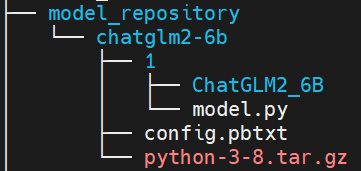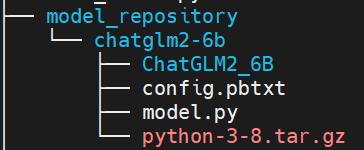chatglm2-6b 模型在 9n-triton 中部署并集成至 langchain 实践 | 京东云技术团队
- 2023-08-16 北京
本文字数:12170 字
阅读完需:约 40 分钟

一.前言
近期, ChatGLM-6B 的第二代版本 ChatGLM2-6B 已经正式发布,引入了如下新特性:
①. 基座模型升级,性能更强大,在中文 C-Eval 榜单中,以 51.7 分位列第 6;
②. 支持 8K-32k 的上下文;
③. 推理性能提升了 42%;
④. 对学术研究完全开放,允许申请商用授权。
目前大多数部署方案采用的是 fastapi+uvicorn+transformers,这种方式适合快速运行一些 demo,在生产环境中使用还是推荐使用专门的深度学习推理服务框架,如 Triton。本文将介绍我利用集团 9n-triton 工具部署 ChatGLM2-6B 过程中踩过的一些坑,希望可以为有部署需求的同学提供一些帮助。
二.硬件要求
部署的硬件要求可以参考如下:
我部署了 2 个 pod,每个 pod 的资源:CPU(4 核)、内存(30G)、1 张 P40 显卡(显存 24G)。
三.部署实践
Triton 默认支持的 PyTorch 模型格式为 TorchScript,由于 ChatGLM2-6B 模型转换成 TorchScript 格式会报错,本文将以 Python Backend 的方式进行部署。
1. 模型目录结构

9N-Triton 使用集成模型,如上图所示模型仓库(model_repository), 它内部可以包含一个或多个子模型(如 chatglm2-6b)。下面对各个部分进行展开介绍:
2. python 执行环境
该部分为模型推理时需要的相关 python 依赖包,可以使用 conda-pack 将 conda 虚拟环境打包,如 python-3-8.tar.gz。如对打包 conda 环境不熟悉的,可以参考 https://conda.github.io/conda-pack/。然后在 config.pbtxt 中配置执行环境路径:
parameters: { key: "EXECUTION_ENV_PATH", value: {string_value: "$$TRITON_MODEL_DIRECTORY/../python-3-8.tar.gz"}}
在当前示例中,$TRITONMODELDIRECTORY="pwd/model_repository/chatglm2-6b"。
注意:当前 python 执行环境为所有子模型共享,如果想给不同子模型指定不同的执行环境,则应该将 tar.gz 文件放在子模型目录下,如下所示:

同时,在 config.pbtxt 中配置执行环境路径如下:
parameters: { key: "EXECUTION_ENV_PATH", value: {string_value: "$$TRITON_MODEL_DIRECTORY/python-3-8.tar.gz"}}
3. 模型配置文件
模型仓库库中的每个模型都必须包含一个模型配置文件 config.pbtxt,用于指定平台和或后端属性、max_batch_size 属性以及模型的输入和输出张量等。ChatGLM2-6B 的配置文件可以参考如下:
name: "chatglm2-6b" // 必填,模型名,需与该子模型的文件夹名字相同backend: "python" // 必填,模型所使用的后端引擎
max_batch_size: 0 // 模型每次请求最大的批数据量,张量shape由max_batch_size和dims组合指定,对于 max_batch_size 大于 0 的模型,完整形状形成为 [ -1 ] + dims。 对于 max_batch_size 等于 0 的模型,完整形状形成为 dims。input [ // 必填,输入定义 { name: "prompt" //必填,名称 data_type: TYPE_STRING //必填,数据类型 dims: [ -1 ] //必填,数据维度,-1 表示可变维度 }, { name: "history" data_type: TYPE_STRING dims: [ -1 ] }, { name: "temperature" data_type: TYPE_STRING dims: [ -1 ] }, { name: "max_token" data_type: TYPE_STRING dims: [ -1 ] }, { name: "history_len" data_type: TYPE_STRING dims: [ -1 ] }]output [ //必填,输出定义 { name: "response" data_type: TYPE_STRING dims: [ -1 ] }, { name: "history" data_type: TYPE_STRING dims: [ -1 ] }]parameters: { //指定python执行环境 key: "EXECUTION_ENV_PATH", value: {string_value: "$$TRITON_MODEL_DIRECTORY/../python-3-8.tar.gz"}}instance_group [ //模型实例组 { count: 1 //实例数量 kind: KIND_GPU //实例类型 gpus: [ 0 ] //指定实例可用的GPU索引 }]
其中必填项为最小模型配置,模型配置文件更多信息可以参考: https://github.com/triton-inference-server/server/blob/r22.04/docs/model_configuration.md
4. 自定义 python backend
主要需要实现model.py 中提供的三个接口:
①. initialize: 初始化该 Python 模型时会进行调用,一般执行获取输出信息及创建模型的操作
②. execute: python 模型接收请求时的执行函数;
③. finalize: 删除模型时会进行调用;
如果有 n 个模型实例,那么会调用 n 次 initialize 和 finalize 这两个函数。
ChatGLM2-6B 的 model.py 文件可以参考如下:
import os# 设置显存空闲block最大分割阈值os.environ['PYTORCH_CUDA_ALLOC_CONF'] = 'max_split_size_mb:32'# 设置work目录
os.environ['TRANSFORMERS_CACHE'] = os.path.dirname(os.path.abspath(__file__))+"/work/"os.environ['HF_MODULES_CACHE'] = os.path.dirname(os.path.abspath(__file__))+"/work/"
import json
# triton_python_backend_utils is available in every Triton Python model. You# need to use this module to create inference requests and responses. It also# contains some utility functions for extracting information from model_config# and converting Triton input/output types to numpy types.import triton_python_backend_utils as pb_utilsimport sysimport gcimport timeimport loggingimport torchfrom transformers import AutoTokenizer, AutoModelimport numpy as np
gc.collect()torch.cuda.empty_cache()
logging.basicConfig(format='%(asctime)s - %(filename)s[line:%(lineno)d] - %(levelname)s: %(message)s', level=logging.INFO)
class TritonPythonModel: """Your Python model must use the same class name. Every Python model that is created must have "TritonPythonModel" as the class name. """
def initialize(self, args): """`initialize` is called only once when the model is being loaded. Implementing `initialize` function is optional. This function allows the model to intialize any state associated with this model.
Parameters ---------- args : dict Both keys and values are strings. The dictionary keys and values are: * model_config: A JSON string containing the model configuration * model_instance_kind: A string containing model instance kind * model_instance_device_id: A string containing model instance device ID * model_repository: Model repository path * model_version: Model version * model_name: Model name """ # You must parse model_config. JSON string is not parsed here self.model_config = json.loads(args['model_config']) output_response_config = pb_utils.get_output_config_by_name(self.model_config, "response") output_history_config = pb_utils.get_output_config_by_name(self.model_config, "history")
# Convert Triton types to numpy types self.output_response_dtype = pb_utils.triton_string_to_numpy(output_response_config['data_type']) self.output_history_dtype = pb_utils.triton_string_to_numpy(output_history_config['data_type']) ChatGLM_path = os.path.dirname(os.path.abspath(__file__))+"/ChatGLM2_6B" self.tokenizer = AutoTokenizer.from_pretrained(ChatGLM_path, trust_remote_code=True) model = AutoModel.from_pretrained(ChatGLM_path, torch_dtype=torch.bfloat16, trust_remote_code=True).half().cuda() self.model = model.eval() logging.info("model init success") def execute(self, requests): """`execute` MUST be implemented in every Python model. `execute` function receives a list of pb_utils.InferenceRequest as the only argument. This function is called when an inference request is made for this model. Depending on the batching configuration (e.g. Dynamic Batching) used, `requests` may contain multiple requests. Every Python model, must create one pb_utils.InferenceResponse for every pb_utils.InferenceRequest in `requests`. If there is an error, you can set the error argument when creating a pb_utils.InferenceResponse
Parameters ---------- requests : list A list of pb_utils.InferenceRequest
Returns ------- list A list of pb_utils.InferenceResponse. The length of this list must be the same as `requests` """ output_response_dtype = self.output_response_dtype output_history_dtype = self.output_history_dtype
# output_dtype = self.output_dtype responses = [] # Every Python backend must iterate over everyone of the requests # and create a pb_utils.InferenceResponse for each of them. for request in requests: prompt = pb_utils.get_input_tensor_by_name(request, "prompt").as_numpy()[0] prompt = prompt.decode('utf-8') history_origin = pb_utils.get_input_tensor_by_name(request, "history").as_numpy() if len(history_origin) > 0: history = np.array([item.decode('utf-8') for item in history_origin]).reshape((-1,2)).tolist() else: history = [] temperature = pb_utils.get_input_tensor_by_name(request, "temperature").as_numpy()[0] temperature = float(temperature.decode('utf-8')) max_token = pb_utils.get_input_tensor_by_name(request, "max_token").as_numpy()[0] max_token = int(max_token.decode('utf-8')) history_len = pb_utils.get_input_tensor_by_name(request, "history_len").as_numpy()[0] history_len = int(history_len.decode('utf-8')) # 日志输出传入信息 in_log_info = { "in_prompt":prompt, "in_history":history, "in_temperature":temperature, "in_max_token":max_token, "in_history_len":history_len } logging.info(in_log_info) response,history = self.model.chat(self.tokenizer, prompt, history=history[-history_len:] if history_len > 0 else [], max_length=max_token, temperature=temperature) # 日志输出处理后的信息 out_log_info = { "out_response":response, "out_history":history } logging.info(out_log_info) response = np.array(response) history = np.array(history) response_output_tensor = pb_utils.Tensor("response",response.astype(self.output_response_dtype)) history_output_tensor = pb_utils.Tensor("history",history.astype(self.output_history_dtype))
final_inference_response = pb_utils.InferenceResponse(output_tensors=[response_output_tensor,history_output_tensor]) responses.append(final_inference_response) # Create InferenceResponse. You can set an error here in case # there was a problem with handling this inference request. # Below is an example of how you can set errors in inference # response: # # pb_utils.InferenceResponse( # output_tensors=..., TritonError("An error occured"))
# You should return a list of pb_utils.InferenceResponse. Length # of this list must match the length of `requests` list. return responses
def finalize(self): """`finalize` is called only once when the model is being unloaded. Implementing `finalize` function is OPTIONAL. This function allows the model to perform any necessary clean ups before exit. """ print('Cleaning up...')
5. 部署测试
① 选择 9n-triton-devel-gpu-v0.3 镜像创建 notebook 测试实例;
② 把模型放在/9n-triton-devel/model_repository 目录下,模型目录结构参考 3.1;
③ 进入/9n-triton-devel/server/目录,拉取最新版本的 bin 并解压:wget http://storage.jd.local/com.bamboo.server.product/7196560/9n_predictor_server.tgz
④ 修改/9n-triton-devel/server/start.sh 为如下:
mkdir logs\rm -rf /9n-triton-devel/server/logs/*\rm -rf /tmp/python_env_*export LD_LIBRARY_PATH=/9n-triton-devel/server/lib/:$LD_LIBRARY_PATHnohup ./bin/9n_predictor_server --flagfile=./conf/server.gflags 2>&1 >/dev/null &sleep 2pid=`ps x |grep "9n_predictor_server" | grep -v "grep" | grep -v "ldd" | grep -v "stat" | awk '{print $1}'`echo $pid
⑤ 运行 /9n-triton-devel/server/start.sh 脚本
⑥ 检查服务启动成功(ChatGLM2-6B 模型启动,差不多 13 分钟左右)
方法 1:查看 8010 端口是否启动:netstat -natp | grep 8010
方法 2:查看日志:cat /9n-triton-devel/server/logs/predictor_core.INFO
⑦ 编写 python grpc client 访问测试服务脚本,放于/9n-triton-devel/client/目录下,访问端口为 8010,ip 为 127.0.0.1,可以参考如下:
#!/usr/bin/python3# -*- coding: utf-8 -*-import syssys.path.append('./base')from multi_backend_client import MultiBackendClientimport triton_python_backend_utils as python_backend_utilsimport multi_backend_message_pb2
import timeimport argparseimport ioimport osimport numpy as npimport jsonimport struct
def print_result(response, batch_size ): print("outputs len:" + str(len(response.outputs)))
if (response.error_code == 0): print("response : ", response)
print(f'res shape: {response.outputs[0].shape}') res = python_backend_utils.deserialize_bytes_tensor(response.raw_output_contents[0]) for i in res: print(i.decode())
print(f'history shape: {response.outputs[1].shape}') history = python_backend_utils.deserialize_bytes_tensor(response.raw_output_contents[1]) for i in history: print(i.decode())
def send_one_request(sender, request_pb, batch_size): succ, response = sender.send_req(request_pb) if succ: print_result(response, batch_size) else: print('send_one_request fail ', response)
def send_request(ip, port, temperature, max_token, history_len, batch_size=1, send_cnt=1): request_sender = MultiBackendClient(ip, port)
request = multi_backend_message_pb2.ModelInferRequest() request.model_name = "chatglm2-6b"
# 输入占位 input0 = multi_backend_message_pb2.ModelInferRequest().InferInputTensor() input0.name = "prompt" input0.datatype = "BYTES" input0.shape.extend([1])
input1 = multi_backend_message_pb2.ModelInferRequest().InferInputTensor() input1.name = "history" input1.datatype = "BYTES" input1.shape.extend([-1]) input2 = multi_backend_message_pb2.ModelInferRequest().InferInputTensor() input2.name = "temperature" input2.datatype = "BYTES" input2.shape.extend([1]) input3 = multi_backend_message_pb2.ModelInferRequest().InferInputTensor() input3.name = "max_token" input3.datatype = "BYTES" input3.shape.extend([1]) input4 = multi_backend_message_pb2.ModelInferRequest().InferInputTensor() input4.name = "history_len" input4.datatype = "BYTES" input4.shape.extend([1])
query = '请给出一个具体示例' input0.contents.bytes_contents.append(bytes(query, encoding="utf8")) request.inputs.extend([input0])
history_origin = np.array([['你知道鸡兔同笼问题么', '鸡兔同笼问题是一个经典的数学问题,涉及到基本的代数方程和解题方法。问题描述为:在一个笼子里面,有若干只鸡和兔子,已知它们的总数和总腿数,问鸡和兔子的数量各是多少?\n\n解法如下:假设鸡的数量为x,兔子的数量为y,则总腿数为2x+4y。根据题意,可以列出方程组:\n\nx + y = 总数\n2x + 4y = 总腿数\n\n通过解方程组,可以求得x和y的值,从而确定鸡和兔子的数量。']]).reshape((-1,)) history = [bytes(item, encoding="utf8") for item in history_origin] input1.contents.bytes_contents.extend(history) request.inputs.extend([input1]) input2.contents.bytes_contents.append(bytes(temperature, encoding="utf8")) request.inputs.extend([input2]) input3.contents.bytes_contents.append(bytes(max_token, encoding="utf8")) request.inputs.extend([input3]) input4.contents.bytes_contents.append(bytes(history_len, encoding="utf8")) request.inputs.extend([input4])
# 输出占位 output_tensor0 = multi_backend_message_pb2.ModelInferRequest().InferRequestedOutputTensor() output_tensor0.name = "response" request.outputs.extend([output_tensor0])
output_tensor1 = multi_backend_message_pb2.ModelInferRequest().InferRequestedOutputTensor() output_tensor1.name = "history" request.outputs.extend([output_tensor1]) min_ms = 0 max_ms = 0 avg_ms = 0 for i in range(send_cnt): start = time.time_ns() send_one_request(request_sender, request, batch_size) cost = (time.time_ns()-start)/1000000 print ("idx:%d cost ms:%d" % (i, cost)) if cost > max_ms: max_ms = cost if cost < min_ms or min_ms==0: min_ms = cost avg_ms += cost avg_ms /= send_cnt print("cnt=%d max=%dms min=%dms avg=%dms" % (send_cnt, max_ms, min_ms, avg_ms))
if __name__ == '__main__': parser = argparse.ArgumentParser() parser.add_argument( '-ip', '--ip_address', help = 'ip address', default='127.0.0.1', required=False) parser.add_argument( '-p', '--port', help = 'port', default='8010', required=False) parser.add_argument( '-t', '--temperature', help = 'temperature', default='0.01', required=False) parser.add_argument( '-m', '--max_token', help = 'max_token', default='16000', required=False) parser.add_argument( '-hl', '--history_len', help = 'history_len', default='10', required=False) parser.add_argument( '-b', '--batch_size', help = 'batch size', default=1, required=False, type = int) parser.add_argument( '-c', '--send_count', help = 'send count', default=1, required=False, type = int) args = parser.parse_args() send_request(args.ip_address, args.port, args.temperature, args.max_token, args.history_len, args.batch_size, args.send_count)
通用 predictor 请求格式可以参考: https://github.com/kserve/kserve/blob/master/docs/predict-api/v2/grpc_predict_v2.proto
6. 模型部署
九数算法中台提供了两种部署模型服务方式,分别为界面部署和 SDK 部署。利用界面中的模型部署只支持 JSF 协议接口,若要提供 JSF 服务接口,则可以参考 http://easyalgo.jd.com/help/%E4%BD%BF%E7%94%A8%E6%8C%87%E5%8D%97/%E6%A8%A1%E5%9E%8B%E8%AE%A1%E7%AE%97/%E6%A8%A1%E5%9E%8B%E9%83%A8%E7%BD%B2.html 直接部署。
由于我后续需要将 ChatGLM2-6B 模型集成至 langchain 中使用,所以对外提供 http 协议接口比较便利,经与算法中台同学请教后使用 SDK 方式部署可以满足。由于界面部署和 SDK 部署目前研发没有对齐,用界面部署时直接可以使用 3.1 中的模型结构,使用 SDK 部署则需要调整模型结构如下:

同时需要在 config.pbtxt 中将执行环境路径设置如下:
parameters: { key: "EXECUTION_ENV_PATH", value: {string_value: "$$TRITON_MODEL_DIRECTORY/1/python-3-8.tar.gz"}}
模型部署代码可以参考如下:
from das.triton.model import TritonModel
model = TritonModel("chatglm2-6b")
predictor = model.deploy( path="$pwd/model_repository/chatglm2-6b", # 模型文件所在的目录 protocol='http', endpoint = "9n-das-serving-lf2.jd.local", cpu=4, memory=30, use_gpu=True, # 根据是否需要gpu加速推理来配置 override = True, instances=2 )
四.集成至 langchain
使用 langchain 可以快速基于 LLM 模型开发一些应用。使用 LLMs 模块封装 ChatGLM2-6B,请求我们的模型服务,主要实现_call 函数,可以参考如下代码:
import jsonimport timeimport base64import structimport requestsimport numpy as npfrom pathlib import Pathfrom abc import ABC, abstractmethodfrom langchain.llms.base import LLMfrom langchain.llms import OpenAIfrom langchain.llms.utils import enforce_stop_tokensfrom typing import Dict, List, Optional, Tuple, Union, Mapping, Any
import warningswarnings.filterwarnings("ignore")
class ChatGLM(LLM): max_token = 32000 temperature = 0.01 history_len = 10 url = "" def __init__(self): super(ChatGLM, self).__init__() @property def _llm_type(self): return "ChatGLM2-6B" @property def _history_len(self) -> int: return self.history_len @property def _max_token(self) -> int: return self.max_token @property def _temperature(self) -> float: return self.temperature def _deserialize_bytes_tensor(self, encoded_tensor): """ Deserializes an encoded bytes tensor into an numpy array of dtype of python objects Parameters ---------- encoded_tensor : bytes The encoded bytes tensor where each element has its length in first 4 bytes followed by the content Returns ------- string_tensor : np.array The 1-D numpy array of type object containing the deserialized bytes in 'C' order. """ strs = list() offset = 0 val_buf = encoded_tensor while offset < len(val_buf): l = struct.unpack_from("<I", val_buf, offset)[0] offset += 4 sb = struct.unpack_from("<{}s".format(l), val_buf, offset)[0] offset += l strs.append(sb) return (np.array(strs, dtype=np.object_)) @classmethod def _infer(cls, url, query, history, temperature, max_token, history_len): query = base64.b64encode(query.encode('utf-8')).decode('utf-8') history_origin = np.asarray(history).reshape((-1,)) history = [base64.b64encode(item.encode('utf-8')).decode('utf-8') for item in history_origin] temperature = base64.b64encode(temperature.encode('utf-8')).decode('utf-8') max_token = base64.b64encode(max_token.encode('utf-8')).decode('utf-8') history_len = base64.b64encode(history_len.encode('utf-8')).decode('utf-8') data = { "model_name": "chatglm2-6b", "inputs": [ {"name": "prompt", "datatype": "BYTES", "shape": [1], "contents": {"bytes_contents": [query]}}, {"name": "history", "datatype": "BYTES", "shape": [-1], "contents": {"bytes_contents": history}}, {"name": "temperature", "datatype": "BYTES", "shape": [1], "contents": {"bytes_contents": [temperature]}}, {"name": "max_token", "datatype": "BYTES", "shape": [1], "contents": {"bytes_contents": [max_token]}}, {"name": "history_len", "datatype": "BYTES", "shape": [1], "contents": {"bytes_contents": [history_len]}} ], "outputs": [{"name": "response"}, {"name": "history"}] } response = requests.post(url = url, data = json.dumps(data, ensure_ascii=True), headers = {"Content_Type": "application/json"}, timeout=120) return response def _call(self, query: str, history: List[List[str]] =[], stop: Optional[List[str]] =None): temperature = str(self.temperature) max_token = str(self.max_token) history_len = str(self.history_len) url = self.url response = self._infer(url, query, history, temperature, max_token, history_len) if response.status_code!=200: return "查询结果错误" if stop is not None: response = enforce_stop_tokens(response, stop) result = json.loads(response.text) # 处理response res = base64.b64decode(result['raw_output_contents'][0].encode('utf-8')) res_response = self._deserialize_bytes_tensor(res)[0].decode() return res_response def chat(self, query: str, history: List[List[str]] =[], stop: Optional[List[str]] =None): temperature = str(self.temperature) max_token = str(self.max_token) history_len = str(self.history_len) url = self.url response = self._infer(url, query, history, temperature, max_token, history_len) if response.status_code!=200: return "查询结果错误" if stop is not None: response = enforce_stop_tokens(response, stop) result = json.loads(response.text) # 处理response res = base64.b64decode(result['raw_output_contents'][0].encode('utf-8')) res_response = self._deserialize_bytes_tensor(res)[0].decode() # 处理history history_shape = result['outputs'][1]["shape"] history_enc = base64.b64decode(result['raw_output_contents'][1].encode('utf-8')) res_history = np.array([i.decode() for i in self._deserialize_bytes_tensor(history_enc)]).reshape(history_shape).tolist() return res_response, res_history @property def _identifying_params(self) -> Mapping[str, Any]: """Get the identifying parameters. """ _param_dict = { "url": self.url } return _param_dict
注意:模型服务调用 url 等于在模型部署页面调用信息 URL 后加上" MutilBackendService/Predict "
五.总结
本文详细介绍了在集团 9n-triton 工具上部署 ChatGLM2-6B 过程,希望可以为有部署需求的同学提供一些帮助。
作者:京东保险 赵风龙
来源:京东云开发者社区 转载请注明出处
版权声明: 本文为 InfoQ 作者【京东科技开发者】的原创文章。
原文链接:【http://xie.infoq.cn/article/5e411250d6807c994e6c1d919】。文章转载请联系作者。
京东科技开发者
拥抱技术,与开发者携手创造未来! 2018-11-20 加入
我们将持续为人工智能、大数据、云计算、物联网等相关领域的开发者,提供技术干货、行业技术内容、技术落地实践等文章内容。京东云开发者社区官方网站【https://developer.jdcloud.com/】,欢迎大家来玩











评论